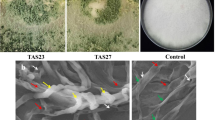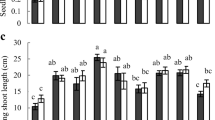Abstract
Beneficial plant-microbe interactions in the rhizosphere are primary determinants of plant health and soil fertility. Some antagonistic fungi have shown great effects toward the growth of plant crops. In this study, two major crops, cotton and potato, were selected to evaluate their growth promotion by the antagonistic fungus Talaromyces flavus. For each plant, five T. flavus isolates were selected from our fungal collection which had shown the highest antagonistic activities against the causal agent of wilt diseases on these plants. In the next step, for every crop, five isolates were used under greenhouse conditions. For evaluation of the plant growth promotion ability of T. flavus isolates, a split-plot trial was arranged in a randomized complete block design with four replications. The main factor was the method of application of T. flavus as a soil treatment, a seed treatment, and a combination of both methods. The subfactor was the use of different fungal isolates. Measured parameters were root length, crown length, plant height, plant fresh weight, and plant dry weight. Results showed that the maximum increase in the above parameters was mediated by the seed treatment method. The most effective isolate for cotton plants was TF-Co-M-23, which increased root length, plant height, plant fresh weight, and plant dry weight by 1.80-, 2.26-, 1.23-, and 1.19-fold, respectively. There were no significant differences among the various treatments affected by T. flavus in terms of crown length. The most effective isolate for potato plants was TF-Po-V-50, which increased root length, crown length, plant height, and plant dry weight by 1.71-, 1.09-, 1.45-, and 3.75-fold, respectively. The overall results of this study suggest that it may be possible to promote cotton and potato growth characteristics by using the antagonistic fungus T. flavus.
Similar content being viewed by others
References
Arora DK (2004) Fungal biotechnology in agricultural, food, and environmental applications. Marcel Dekker, New York, p 475
Ayer WA, Racok JS (1990) The metabolites of Talaromyces flavus: Part 1. Metabolites of the organic extracts. Can J Chem 68:2085–2094
Baker R (1988) Trichoderma spp. as plant growth stimulants. CRC Crit Rev Biotech 7:97–106
Bewley JD, Black M, Halmer P (2006) The encyclopedia of seeds: science, technology, and uses. Oxfordshire. CABI Publishing, UK, p 828
Botelho GR, Hagler LCM (2006) Fluorescent pseudomonads associated with the rhizosphere of crops: an overview. Braz J Microbiol 37:401–416
Chang YC, Chang YC, Baker R, Kleifeld O, Chet I (1986) Increased growth of plants in the presence of the biological control agent Trichoderma harzianum. Plant Dis 70:145–148
Chet I, Baker R (1981) Isolation and biocontrol potential of Trichoderma hamatum from soil naturally suppressive to Rhizoctonia solani. Phytopathology 71:286–290
Contreras-Cornejo HA, Macias-Rodriguez L, Cortes-Penagos C, Lopez-Bucio J (2009) Trichoderma virens, a plant beneficial fungus, enhances biomass production and promotes lateral root growth through an auxin-dependent mechanism in Arabidopsis. Plant Physiol 149:1579–1592
Domsch KH, Gams W, Anderson TH (1980) Compendium of soil fungi, vol 1. Academic Press, London, pp 752-759
Dutta BK (1981) Studies on some fungi isolated from the rhizosphere to tomato plants and the consequent prospect for the control of Verticillium wilt. Plant Soil 63:209–216
Gadd GM (1999) Fungal production of citric and oxalic acid: importance in metal speciation, physiology and biogeochemical processes. Adv Microb Physiol 41:47–92
Hajieghrari B (2010) Effects of some Iranian Trichoderma isolates on maize seed germination and seedling vigor. Afr J Biotech 9:4342–4347
Harman GE (2000) Myths and dogmas of biocontrol: changes in perceptions derived from research on Trichoderma harzianum T-22. Plant Dis 80:377–393
Harvey PR, Warren RA, Wakelin S (2009) Potential to improve root access to phosphorus: the role of non-symbiotic microbial inoculants in the rhizosphere. Crop Pasture Sci 60:144–151
Heydari A, Misaghi IJ (1998) The impact of herbicides on the incidence and development of Rhizoctonia-solani-induced cotton seedling damping-off. Plant Dis 82:110–113
Heydari A, Misaghi IJ (2003) The role of rhizosphere bacteria in herbicide-mediated increase in Rhizoctonia solani-induced cotton seedling damping-off. Plant Soil 257:391–396
Hyakumachi M, Kubota M (2004) Biological control of plant diseases by plant growth promoting fungi. In: Proceedings of the international seminar on biological control of soil-borne plant disease. Japan–Argentina Joint Study, pp 87-123
Kleifeld O, Chet I (1992) Trichoderma harzianum interaction with plants and effects on growth response. Plant Soil 144:267–272
Kucey RMN, Janzen HH, Leggett ME (1989) Microbially mediated increases in plant available phosphorus. Adv Agron 42:199–228
Le Floch G, Rey P, Benizri E, Benhamou N, Tirilly Y (2003) Impact of auxin-compounds produced by the antagonistic fungus Pythium oligandrum or the minor pathogen Pythium group F on plant growth. Plant Soil 275:459–470
Madi L, Katan T, Katan J, Henis Y (1997) Biological control of Sclerotium rolfsii and Verticillium dahliae by Talaromyces flavus is mediated by different mechanisms. Phytopathology 87:1054–1060
Marois JJ, Fravel DR, Papavizas GC (1984) Ability of Talaromyces flavus to occupy the rhizosphere. Soil Biol Biochem 16:387–390
Masunaka A, Hyakumachi M, Takenaka S (2011) Plant growth-promoting fungus, Trichoderma koningi suppresses isoflavonoid phytoalexin vestitol production for colonization on/in the roots of Lotus japonicus. Microb Environ 26:128–134
Menendez AB, Godeas A (1998) Biological control of Sclerotinia sclerotiorum attacking soybean plants: degradation of the cell wall of this pathogen by Trichoderma harzianum. Mycopathology 142:153–160
Naraghi L, Heydari A, Ershad D (2006) Sporulation and survival of Talaromyces flavus on different plant material residues for biological control of cotton wilt caused by Verticillium dahliae. Iran J Plant Pathol 42:381–397 (in Persian with English summary)
Naraghi L, Zareh-Maivan H, Heydari A, Afshari-Azad H (2007) Investigation of the effect of heating, vesicular arbuscular mycorrhiza and thermophillic fungus on cotton wilt disease. Pak J Biol Sci 10:1596–1603
Naraghi L, Heydari A, Rezaee S, Razavi M, Afshari-Azad H (2010a) Biological control of greenhouse cucumber Verticillium wilt disease by Talaromyces flavus. Phytopathol Mediterr 49:321–329
Naraghi L, Heydari A, Rezaee S, Razavi M, Jahanifar H (2010b) Study on antagonistic effects of Talaromyces flavus on Verticillium albo-atrum, the causal agent of potato wilt disease. Crop Prot 29:658–662
Naraghi L, Heydari A, Rezaee S, Razavi M, Jahanifar H, Mahmoodi Khaledi E (2010c) Biological control of tomato Verticillium wilt disease by Talaromyces flavus. J Plant Prot Res 50:360–365
Ousley MA, Lynch JM, Whipps JM (1994a) Potential of Trichoderma spp. as consistent plant growth stimulators. Biol Fertil Soils 17:85–90
Ousley MA, Lynch JM, Whipps JM (1994b) The effects of addition of Trichoderma inocula on flowering and shoot growth of bedding plants. Sci Hortic 59:147–159
Pandya U, Saraf M (2010) Application of fungi as a biocontrol agent and their biofertilizer potential in agriculture. J Adv Dev Res 1:90–99
Paulitz TM, Windham T, Baker R (1986) Effect of peat vermiculite mixes containing Trichoderma harzianum on increased growth response of radish. J Am Soc Hortic Sci 111:810–814
Phuwiwat W, Soytong K (1999) Growth and yield response of Chinese radish to application of Trichoderma harzianum. Thammasat Int J Sci Tech 4:68–71
Phuwiwat W, Soytong K (2001) The effect of Penicillium notatum on plant growth. Fungal Divers 8:143–148
Siddiqui ZA, Akhtar MS, Futai K (2008) Mycorrhizae: sustainable agriculture and forestry. Springer, New York, p 365
Sudha LJ, Kuberan T, Anbaraj J, Sundaravadivelan C, Kumar P, Dhanaseeli M (2011) Effect of plant growth promoting fungal inoculant on the growth of Arachis hypogea (L.) and its role on the induction of systemic resistance against Rhizoctonia solani. Int J Appl Biol Pharm Tech 2:222–232
Tjamos EC, Fravel DR (1997) Distribution and establishment of the biocontrol fungus Talaromyces flavus in soil and on roots of solanaceous crops. Crop Prot 16:135–139
Wakelin SA, Warren RA, Harvey PR, Ryder MH (2004) Phosphate solubilization by Penicillium spp. closely associated with wheat roots. Biol Fertil Soils 40:36–43
Whitelaw MA (2000) Growth promotion of plants inoculated with phosphate solubilizing fungi. Adv Agron 69:99–151
Windham MT, Elad L, Baker R (1986) A mechanism for increased plant growth induced by Trichoderma spp. Phytopathology 76:518–521
Zaki K, Misaghi IJ, Heydari A, Shatla MN (1998) Control of cotton seedling damping-off in the field by Burkholderia cepacia. Plant Dis 82:291–293
Author information
Authors and Affiliations
Corresponding author
Rights and permissions
About this article
Cite this article
Naraghi, L., Heydari, A., Rezaee, S. et al. Biocontrol Agent Talaromyces flavus Stimulates the Growth of Cotton and Potato. J Plant Growth Regul 31, 471–477 (2012). https://doi.org/10.1007/s00344-011-9256-2
Received:
Accepted:
Published:
Issue Date:
DOI: https://doi.org/10.1007/s00344-011-9256-2




